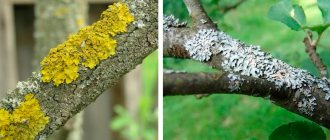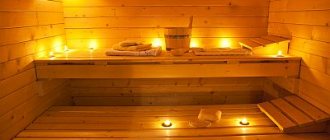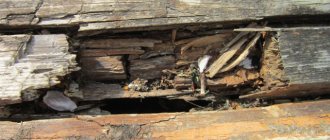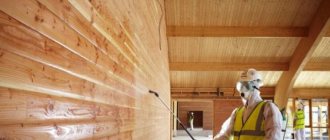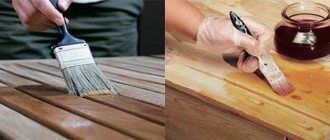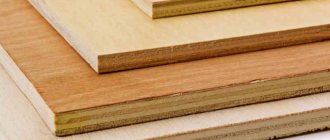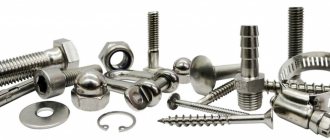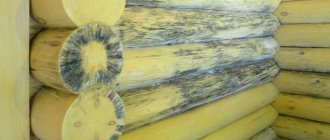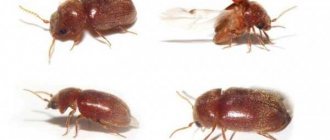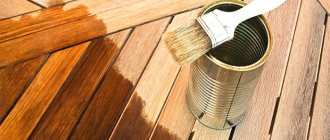A dacha made of wood is not only a reason for special pride, but also a cause for concern for the owner. Along with the threat of destruction of the building by insects and excess moisture, there is a risk of losing all acquired property literally in a matter of hours as a result of a fire. It is for this reason that before building a structure, it is important to study ways to protect wood from rotting and fire. By spending very little money and effort on treating wooden surfaces with special substances, you will extend their service life for many years.
Fire protection concept
In accordance with fire safety requirements, the fire resistance of building structures must be ensured by:
- constructive solutions;
- use of appropriate building materials;
- use of fire protection means.
To protect wood from fire and increase the fire resistance limits of wooden structures, fire-retardant compounds (fire-retardant impregnations, fire-retardant varnishes and paints, fire-retardant coatings) are used.
Fire retardant treatment options:
- applying compounds to the surface of wood to form a fire retardant layer;
- introduction of fire retardants deep into wood using deep impregnation methods.
How to protect your roof from wood fires
Antiseptic and fire retardant treatment
wooden structures and building parts must be provided for during construction and renovation work.
In buildings of all degrees of fire resistance, the roof, rafters and sheathing of attic coverings, floors, doors, gates, window frames and lanterns, as well as the finishing (including cladding) of walls and ceilings, regardless of the normalized limits for the spread of fire along them, may be made of combustible materials. At the same time, the rafters and sheathing of the attic coverings
(except for buildings of fire resistance class V) should
be subjected to fire retardant treatment
.
Protection of wooden structures from fire and from rotting
, is carried out by two methods - constructive and chemical.
To constructive measures to protect wood from fire
include: separating it from the source of ignition or fencing it with fireproof barriers.
This also includes the use of hollow-core wooden structures for floors and coverings, in which the absence of air gaps provides a higher guarantee against fire
than in hollow structures.
In the case of stove heating, it is necessary to provide separation between the chimney and wooden structures.
Constructive measures consist of rational planning of premises and selection of optimal parameters of the structure. For example, the number of floors and the area of a building with wooden structures are limited. Special fire walls
(firewalls) must divide buildings into separate volumes.
It is RECOMMENDED that air spaces in coating structures be divided into compartments using diaphragms made of asbestos-cement sheets and other non-combustible materials to reduce air leaks in fire conditions
.
Structural measures and protective wood treatments
should also provide:
- protection of wood structures
from direct moisture from precipitation, groundwater and melt water; - protection of wood structures
from freezing, capillary and condensation moisture; - systematic drying of wood structures
by creating a drying temperature and humidity regime (natural and forced ventilation of rooms, installation of drying vents and aerators in structures and parts of buildings).
Wooden structures must be open
, well ventilated, if possible, accessible in all parts - for inspection, preventive repairs, resumption of protective wood treatment, etc.
Structural measures are complemented by plastering
or by nailing thin sheets of asbestos cement. It is also practiced to stick aluminum light- and heat-reflecting foil or non-flammable polymer films on the structure.
Plastering the surface and lining wood with asbestos-cement sheets is one of the reliable ways to obtain fire-resistant structures
.
To protect wall structures and coverings from fire
Non-combustible or low-combustible materials should be used as fillers and for roofing. It is RECOMMENDED that walls and ceilings be made with a smooth surface, without wooden projections indoors. You should also use massive structures made of beams, logs and glued elements with rounded corners and carefully planed and plastered surfaces.
To chemical means of protecting wood from fire
include various types of coatings (including clay), fire-resistant paints and impregnating compositions based on low-molecular and high-molecular compounds. Coatings are intended for wooden structures protected from direct atmospheric influences. They are prepared at the workplace and applied with a brush in two steps with an interval of 12 hours. 1.2…1.5 kg of fire retardant is consumed per 1 m² of treated surface.
Coatings are used to cover wooden structures that do not require painting.
(rafters, purlins, etc.).
Coating is not scarce and economical
based on lime-clay dough, table salt and water (IGS). Salt is added to improve adhesion (setting) to wood, but at the same time it causes corrosion of metal parts of structures.
Superphosphate coating
consists (in % by weight) of superphosphate -70% and water -30%. After mixing, its shelf life is 7 hours. After applying this coating, the surface of the structures becomes white.
For fire protection
— elements of wooden roof structures are impregnated with a special solution (a mixture of ammonium sulfate with ammonium phosphate acid or sodium with phosphate acid in a 1:1 ratio) of 15-20% concentration.
Table 2: Material consumption for fire retardant coatings of wooden structures.
| p/p | Name of materials | Meter | Consumption of materials | Types of work performed |
| 1 | 2 | 3 | 4 | 5 |
| 1 | Diammonium phosphate | per 1 m³ of wood in structures | 7.1 kg | Fire protection of wooden structures (arches, beams, mauerlats, rafters and trusses) |
| 2 | Ammonium sulfate | 1.77 kg | ||
| 3 | Kerosene contact | 1.06 kg | ||
| 4 | Diammonium phosphate | per 1 m² of treated surface | 0.229 kg | Fire protection of roof sheathing, coverings and decking on roof trusses |
| 5 | Ammonium sulfate | 0.0575 kg | ||
| 6 | Kerosene contact | 0.035 kg |
Or fire protection
:
- fire-retardant paints (MF-K) - 0.6 kg/m²
of coating area; - the same with phenol alcohol - 0.5 kg/m²
of area covering wooden structures.
To protect wooden structures from fire
silicate, chloride, phosphate, and organosilicon paints are used. Based on their performance characteristics, they are divided into weather-resistant, used for outdoor structures, and water-resistant, used for indoor structures. When applying paints to structures, the wood humidity should be no more than 20%, and the air temperature should be no less than 10°C. Paints are applied with a brush or spray gun.
Table 3: Compositions (% by weight) of silicate fire retardant paints for wooden roof truss systems.
| p/p | Name of materials | SK-G | SK-HEM | SK-L | |
| primer | dye | ||||
| 1 | 2 | 3 | 4 | 5 | 6 |
| 1 | Liquid soda glass (density 1.3; modulus below 2.7) | 37,1 | 37,1 | 37,1 | 54,0 |
| 2 | Chalk | 37,1 | 37,1 | 36,5 | — |
| 3 | Glycerol | 1,9 | 1,9 | 1,9 | — |
| 4 | Zinc white | 1,9 | 1,9 | 1,9 | — |
| 5 | Iron minium | — | — | 0,6 | — |
| 6 | Lithopon | — | — | — | 39,0 |
| 7 | Asbestos dust | — | — | — | 7,0 |
| 8 | Water | 22 | 12 | 12 | — |
| NOTE: SK-CHEM paint is prepared in a chlorinated paraffin emulsion having the composition (parts by weight), chlorinated paraffin - kaolin -2, water -4. | |||||
The basis of silicate protective paints SK-G, SK-KHEM, SK-L (Table 1) is liquid glass. Paints are prepared several hours before application. The wood is painted in two layers, drying the first layer for 12 hours. Paint consumption
per 1 m² of surface is 500...600 g.
Recently, methods of protecting wood from fire have become widespread, based on impregnation with polymers. Phenolic, urea, furan, and organosilicon low-viscosity oligomers and solutions that have a stabilizing and protective effect are used.
The principle of operation of fire retardants
Fire tests of unprotected wood
Photo 1.
Untreated wood ignites when exposed to fire.
Photo 2.
Burning of unprotected wood continues without a flame source
Fire protection of wood comes down to the introduction of substances into the wood that prevent the combustion process.
The principle of the fire-retardant action of these substances is based on the fact that when treated wood is exposed to fire, non-flammable gases and a foam-coke layer are formed, which remove heat from the surface of the wood and push aside oxygen that supports combustion. Below are photographs describing the principle of operation of the fire retardant composition ZELEST ECOPIROL FORTE, as well as photographs of fire tests of unprotected wood.
The greater the depth of impregnation of wood with fire retardants, the greater the duration of the fire retardant effect.
Operating principle of fire retardant impregnation
Photo 3.
The tinting composition allows you to control the quality of fire protection
Photo 4.
When exposed to fire, a foam-coke layer is formed, which prevents the burning of wood.
Photo 5.
Combustion stops immediately after the cessation of fire exposure
Photo 6.
Appearance of wood after removing the foam-coke layer
Fire tests
All fire retardant compounds for wood are divided into two groups according to their effectiveness. The compositions of the first group transfer wood to the category of difficult-to-burn materials, the second - to the category of difficult-to-flammable ones.
Photo 7.
Installation for testing fire retardant compounds according to GOST 53292
Photo 8.
Appearance of wood after fire retardant tests according to GOST 53292
Fire retardant efficiency is assessed according to the GOST R 53292-2009 method and is determined by the weight loss of wood samples in % when exposed to fire for 2 minutes.
If the weight loss is no more than 9%, fire retardant efficiency group I is established for the fire retardant composition. If the weight loss is more than 9%, but not more than 25%, fire retardant efficiency group II is established for the fire retardant composition. If the weight loss is more than 25%, it is considered that this composition does not provide fire protection for wood and is not fire retardant.
Aging resistance
If the service life of fire retardant compounds exceeds one year, then additional tests for aging resistance are required.
Fire-resistant wooden structures are often used in conditions where there is no free access to them (attic floors). In such cases, the problem of maintaining fire retardant properties over a long period of time becomes of great importance.
SNiP 21-01—97* (clause 7.12) requires the technical documentation to indicate the frequency of replacement of fire retardants or their restoration depending on operating conditions.
Certificate requirements
Fire retardant compounds for wood and wood-based materials are subject to mandatory certification.
The certificate of compliance with fire safety requirements is issued by accredited certification bodies. The objectivity and reliability of the results is confirmed by the relevant test reports.
In accordance with the Federal Law on Fire Safety Requirements Federal Law No. 123, the product is officially recognized as fire retardant only in case of successful tests for fire retardant effectiveness in accordance with GOST 53292-2009.
Before Federal Law No. 123 and GOST 53292-2009 came into force, tests of fire retardant compounds for wood were carried out according to GOST 16363 in accordance with SNIP 251. Currently, GOST 16363 has lost force.
How to protect your roof from wood rot
Drying and protecting wood from damage by fungal diseases are of great importance for the durability of wooden structures and structures.
Increased humidity of wood in structures creates conditions for it to be damaged by wood-destroying fungi. As a result of the activity of house fungi, wood rots.
Wood rotting
occurs as a result of the activity of house mushrooms: true, white, filmy house mushrooms, as well as shaft or lamellar house mushrooms.
The mycelium of house mushrooms feeds mainly on wood fiber (cellulose), causing destructive rotten wood rot
, leading to the destruction of wooden elements. The life activity of house mushrooms occurs at temperatures from +3°C to +45°C and begins at an average wood moisture content of at least 20%.
Options for damage to damp wood by rotten and sieve rot
are shown in Fig. 2.
Rotten rot
(external and internal) - in the affected wood, numerous longitudinal and transverse cracks are visible (Fig. 2, item 1). The color of the affected wood ranges from brown to dark brown. Such rot breaks up into prisms and is easily rubbed with your fingers.
Sieve rot
(Fig. 2, item 2) are located in the area of the core or mature wood. Such rot represents areas of flabby wood that easily deforms when pressed. The color of the affected wood is brown or red-brown with small white or yellowish spots stretched along the grain.
The main prevention of the fight against rotting of elements of wooden structures is protection from constant and systematically repeated moisture, as well as ensuring their good ventilation.
When carrying out repairs to prevent the development of fungal diseases
the following requirements must be met:
- New wood brought in for repairs must be insulated from damage.
- All rotten wood should be removed by first spraying structures affected by house fungi and healthy wood adjacent to the affected areas.
- Rotten elements are removed, including healthy areas of at least 40...60 cm in length.
- Surface rot is removed by stripping the surface of the structures down to layers of healthy-looking wood - with normal color and strength. It is necessary to create appropriate conditions for drying the wood - air and intensive natural ventilation.
- All cleaned rotten wood, fungal deposits, etc.
burned in the furnace of a boiler or on a fire. - Brick surfaces that came into contact with rotten elements of wooden structures and located close to them should also be disinfected after cleaning them from fungal growths. To do this, they are sprayed with antiseptics and burned with blowtorches, observing fire safety requirements.
- When performing work to remove affected areas of wooden basement structures, it is also necessary to remove the top layer of earth 10...15 cm thick with mandatory preliminary disinfection of it with a solution of copper or iron sulfate. The soil should be taken to a landfill or buried outside the construction area.
- When carrying out repairs, constructive measures are provided to ensure the creation of a normal regime for wooden structures (waterproofing, installation of vents, blind areas, protection from precipitation).
From chemicals used to kill fungus
, the most effective are 5...10% aqueous solution of copper or iron sulfate, as well as antiseptic paste grade 200.
To combat rotting of wooden structures
use antiseptics.
Term
The action of antiseptic
depends on a number of reasons
:
- Conditions of service of the structure.
- Depth of penetration of antiseptic into the thickness of wood and its quality.
- Concentration of solution and type of wood.
Antiseptics are divided into two groups
: water soluble (inorganic) and oily (organic). Antiseptics are required to be highly toxic (poisonous) to wood-growing fungi and to retain this property for a long time. At the same time, it is necessary that they are harmless to people, do not destroy metal fasteners (bolts, plates, nails, etc.) and penetrate most deeply into the thickness of the wood.
The moisture content of wood to be impregnated with antiseptics should not exceed 25%. At higher humidity, the quality of antiseptic
is greatly reduced, and when coated with oily antiseptics, it does not reach the goal and may even be negative. The required moisture content of wood may be greater depending on the method of antiseptic treatment of it, for example, when soaking in hot baths.
Wood surface before antiseptic treatment
must be thoroughly cleaned of bark, lime, ice and dirt.
Protective treatment
of elements should be carried out after they are fully prepared:
- in places of filing;
- in places where cuts are made;
- in places of drilling, etc.
Antiseptic treatment with aqueous solutions
undisassembled (repaired) structures and assortments should be carried out mainly using a hydraulic remote control, directing the jet along all cracks and places of mating (connections) of structures.
A. Antiseptic treatment of wood with aqueous solutions
To prepare an aqueous solution
the water must be heated to a boil, after which the antiseptic with dye is poured in and the composition is mixed with wooden spatulas until completely dissolved.
Surface antiseptic
is carried out twice, without skipping, over the entire surface to be treated (with breaks of up to 2 hours to dry the first layer) by spraying from a hydraulic remote control or applying brushes.
B. Antiseptic treatment of wood with oily antiseptics
Oily antiseptics
applied to surfaces by mechanized or manual methods.
It is NOT RECOMMENDED to process materials near furnaces and pipes (flammable).
B. Antiseptic treatment of wood in hot baths
Hot baths with an aqueous antiseptic solution are used for mass shallow antiseptic treatment
elements from the small timber range.
The exposure time of products and timber in a hot aqueous solution at temperatures up to +90°C is 20...25 minutes, in oily antiseptics at temperatures up to +70°C is 25...30 minutes.
When impregnating wood in baths
:
- the wood is placed in a container and loaded into the bath;
- < hot solution is periodically added to the bath.
D. Dry antiseptic treatment of wood
Dry antiseptic
For safety reasons, this can only be done indoors.
Dry antiseptic treatment of tow or felt
is done as follows:
- before processing the material, felt or tow is unrolled and cut to the required size;
- felt or tow is spread on the striker (plank flooring) in a layer of up to 5 cm;
- sprinkle with powdered antiseptic
and beat the powder into tow or felt with sticks; - then the material is turned over and the operation is repeated;
- The material processed in this way is removed from the striker and placed in a stack before being placed into the case.
D. Wet treatment of felt and tow with an antiseptic
Antiseptic with aqueous solutions
felt or tow as follows:
- before antisepticizing the material with aqueous solutions, bales of felt or tow are unrolled and cut to the required size;
- placed in a bath and filled with an aqueous antiseptic solution
; - After impregnation of the material with the solution, the material is wrung out and placed on boards to dry.
Antiseptic with an oily composition
is done as follows:
- before antisepticizing the material with oily solutions, bales of felt or tow are unrolled and cut to the required size;
- spread on lattice boards and pour an oily solution
; - After impregnation of the material with the solution, it is dried.
K. Wet treatment of sawdust with an antiseptic
Mixing sawdust with antiseptics is carried out at a sawdust moisture content of 30...40%.
Sawdust is antiseptic as follows:
- Before treating with an antiseptic, the sawdust is sifted, bark and wood chips are removed;
- sawdust is poured onto the striker and watered with an antiseptic solution
; during the watering process, the sawdust is mixed so that all the material is saturated with the antiseptic; - After impregnating the sawdust with the solution, they are dried.
For cleaning and treating wood surfaces
Antiseptics will be required according to Table 1.
Table 1: Consumption of antiseptics per 1 m² of wood surface
| p/p | Name of antiseptic | Unit. | For ordinary mass wood processing | The same for individual places | The same for double wood processing |
| 1 | 2 | 3 | 4 | 5 | 6 |
| 1 | Antiseptic aqueous solution | l | 0,7 | 0,7 | 1,4 |
| 2 | Bitumen paste grade 100 | kg | 0,342 | 0,320 | 0,678 |
| 3 | Same brand 200 | « | 0,652 | 0,620 | 1,290 |
| 4 | Oily antiseptic | kg | 0,608 | 0,580 | 1,220 |
| 5 | Coal paste grade 100 | kg | 0,462 | 0,448 | 0,920 |
| 6 | Same brand 200 | « | 0,863 | 0,848 | 1,720 |
| 7 | Extract paste grade 100 coal | kg | 0,472 | 0,465 | 0,960 |
| 8 | Same brand 200 | « | 0,619 | 0,60 | 1,24 |
| 9 | Silicate paints (SK-G, SK-KHEM, SKL) | kg | 0,564 | — | — |
| 10 | Chlorinated paraffin emulsion | kg | 0,5 | — | — |
Considering the poisonous and dangerous
In terms of fire protection
properties of antiseptics
, their storage must be carried out in accordance with special instructions.
Preparation and application of antiseptic preparations
should be done in overalls (overalls or clothing that tightly covers the body, gloves and boots), and when working with powdered antiseptics, in addition, in goggles and respirators.
To protect structures from weathering, moisture, and decay, it is RECOMMENDED to use various paint and varnish coatings. Natural drying oils are a common type of coating, but over time their protective properties weaken. Adding resins and pigments to drying oils increases the durability of coatings
.
Good protective properties
have artificial drying oils.
Glued beams coated with oxol linseed oil
do not delaminate in the open air and do not warp, whereas in beams without coating, defects appear after 7...12 months.
The use of oil paints on artificial or natural drying oil is quite effective.
Paints and enamels have good properties
filled with
aluminum powder
. Aluminum flakes form a continuous reflective surface without interfering with moisture and air exchange in wood. This advantage of the powder is complemented by its water-repellent properties, lack of swelling and ability to reflect heat rays.
Parts painted with aluminum paints are much more flammable than unpainted wood. It is advisable to use such paints to cover adhesive beams, trusses, wall panels, canopies, canopies over platforms.
High protective effect against house fungi
has an antiseptic based on waste from the production of the product ionol.
It contains low molecular weight polyisobutylene, lysols, ionol and volatile organic liquids. Products are antiseptic
in baths or by spraying. A protective film of lysols and ionol is formed on the surface of the impregnated wood, and the solvent evaporates without additional drying.
Antiseptic
RECOMMENDED for the protection of wooden elements, floors, cooling towers, bridges, sleepers.
Another method of protective treatment of wooden parts and structures is surface coating with brushes or spraying with adhesive components from spray guns. Adhesive components can be sulfate alkalis, bitumen, clay, coal tar varnish
etc.
Supporting parts of structures
.
Which fire protection group to choose
Paradoxical as it may seem, according to statistics, the probability of a fire from low-power ignition sources is higher than the probability of a fire from high-power sources.
Fires often occur from an unextinguished cigarette, an accidental spark, a short circuit in the electrical wiring, etc. According to various sources, spontaneous combustion of wood can occur after 20 hours at 166°C.
Logic dictates that in such cases, to protect wood from fire, it is sufficient to use fire retardant compounds of the 2nd group of fire retardant efficiency. The most reliable fire protection of wood is provided by fire retardant compounds with the 1st (highest) group of fire retardant efficiency.
………………….
When using fire retardants for wood, it is very important to follow the recommended consumption.
Fig 1.
Graph of the dependence of the probability of a fire on the thermal power of the ignition source
Methods of protection against rotting
Temperature changes, precipitation, and solar radiation lead to untimely rotting of wood. The first signs of decay are the appearance of mold and mildew. Large areas indicate that the material can no longer be saved. If wooden products or buildings experience atmospheric disturbances, high humidity from precipitation and condensation, it would not be a bad idea to carry out preventive work that will protect the wood from rotting.
The best helpers in this matter are antiseptics, which are pastes or liquid solutions. Some of them are universal, that is, they protect the material not only from moldy fungi, but also from beetles. Examples of such compositions are two popular products.
PINOTEX IMPRA is used for treating wooden surfaces that are not subject to further decoration. Usually these are beams, roofing straps, sheathing parts, that is, hidden parts of buildings. The impregnation is green. The appearance of mold, blue stains, fungus and rot is excluded on wood coated with it.
Recent Entries
Lilac perennials that are beautiful, compact and do not crowd out other plants Why when buying seedlings you should not take the sellers’ word for it and how to determine the age of the plant using 3 signs Tomato seedlings have turned purple or whitish: why the color has changed and how to save the plants
Antiseptic Pinotex Impra goes on sale in large-volume containers. Product price: 3 l – 1100 rubles, 10 l – 3350 rubles
Senezh Ecobio is used both as an independent coating and as a primer for varnish or paint. 2-3 layers of the product protect wood from rotting for 30 years.
If the wooden surface was originally treated with varnish, paint, drying oil or other water-repellent agents, SENEZH ECOBIO is useless
Fire retardant formulations
Among the means for fire protection of wood, the most widely used are impregnating compositions, which are aqueous solutions of fire retardants.
The active ingredients in these formulations are mainly the following compounds:
- phosphates (eg diammonium phosphate)
- potash
- boron compounds (borates)
In addition, compositions are produced that are sold in the form of powder for dilution with water: VANN-1, NLA-8, MS, etc. For deep impregnation of wood, compositions of the MS-1:1 type are produced.
Fire retardant compounds based on alkali metal silicates (liquid glass) are disappearing from the market, despite their low cost, because... they tend to crumble, crack and quickly lose their decorative appearance.
How to protect wood from insect damage
Damage to wood by insects
in most cases it turns out to be more serious than fungal damage. Insects eat holes in the wood, which dramatically weaken wooden structures. Controlling insects is more difficult than controlling fungi.
from insect pests and mollusks has some features
. Insects can damage both a growing tree and felled wood, leaving numerous tunnels in it or completely destroying the wood tissue.
Pests that attack a growing tree include longhorned beetles, borers, and horntails. The larvae of these insects remain in the timber and continue their activity in structures until the adult beetles emerge. However, a new infection does not occur, since the larvae need fresh, damp wood to feed on.
The main technical pests of wood
Infestations of terrestrial wooden structures include
grinder beetles
(furniture and houseware),
ship-boring beetles, longhorn beetles, and termites
, and underwater marine structures include
shipworms
. Wood is destroyed mainly by beetle larvae.
Like mushrooms, wood borer larvae require certain conditions for their development - access to air, positive temperature, limited content of resinous substances.
Strong effect in the fight against such pests
provides coal (creazote) and anthracene oil, kerosene, turpentine, phenol, tar, naphthalene. These substances in various combinations are applied to the surface of wooden structures with paint brushes or using a sprayer with a flow rate of 300...500 g/m².
The fight against termites is carried out by impregnating wood
petroleum products, anthracene oil, pentachlorophenol.
The main method of combating marine wood borers is deep impregnation of wood with anthracene or shale oil mixed with pentachlorophenol and oxydiphenyl in organic solvents.
Good results are also obtained by treating wood with copper naphthenate in organic solvents with a copper content in the solution of at least 3%.
In the absence or poor performance of coating wooden structures with fire retardants, the rate of fire spread in the attic sharply increases and the fire resistance of structures decreases
.
